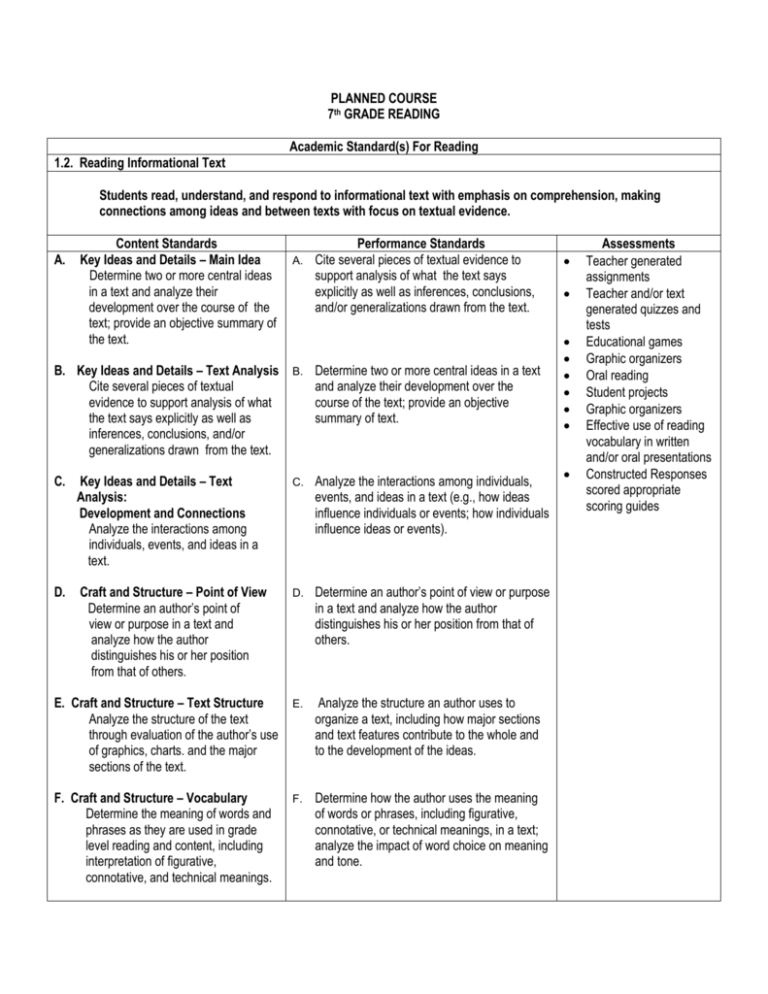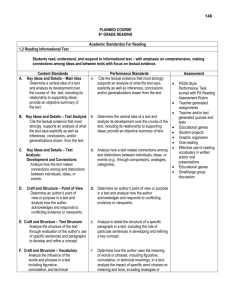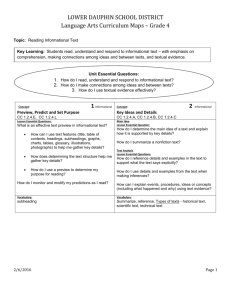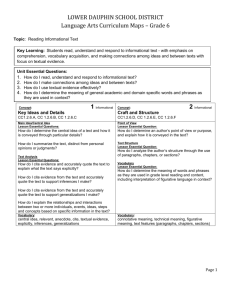7th Grade Planned Course
advertisement

PLANNED COURSE 7th GRADE READING Academic Standard(s) For Reading 1.2. Reading Informational Text Students read, understand, and respond to informational text with emphasis on comprehension, making connections among ideas and between texts with focus on textual evidence. A. Content Standards Key Ideas and Details – Main Idea Determine two or more central ideas in a text and analyze their development over the course of the text; provide an objective summary of the text. A. Performance Standards Cite several pieces of textual evidence to support analysis of what the text says explicitly as well as inferences, conclusions, and/or generalizations drawn from the text. B. Key Ideas and Details – Text Analysis B. Determine two or more central ideas in a text Cite several pieces of textual and analyze their development over the evidence to support analysis of what course of the text; provide an objective the text says explicitly as well as summary of text. inferences, conclusions, and/or generalizations drawn from the text. C. Key Ideas and Details – Text Analysis: Development and Connections Analyze the interactions among individuals, events, and ideas in a text. C. Analyze the interactions among individuals, events, and ideas in a text (e.g., how ideas influence individuals or events; how individuals influence ideas or events). D. Craft and Structure – Point of View Determine an author’s point of view or purpose in a text and analyze how the author distinguishes his or her position from that of others. D. Determine an author’s point of view or purpose in a text and analyze how the author distinguishes his or her position from that of others. E. Craft and Structure – Text Structure Analyze the structure of the text through evaluation of the author’s use of graphics, charts. and the major sections of the text. E. Analyze the structure an author uses to organize a text, including how major sections and text features contribute to the whole and to the development of the ideas. F. Craft and Structure – Vocabulary Determine the meaning of words and phrases as they are used in grade level reading and content, including interpretation of figurative, connotative, and technical meanings. F. Determine how the author uses the meaning of words or phrases, including figurative, connotative, or technical meanings, in a text; analyze the impact of word choice on meaning and tone. Assessments Teacher generated assignments Teacher and/or text generated quizzes and tests Educational games Graphic organizers Oral reading Student projects Graphic organizers Effective use of reading vocabulary in written and/or oral presentations Constructed Responses scored appropriate scoring guides G. Integration of Knowledge and Ideas – Diverse Media Compare and contrast a text to an audio, video, or multimedia version of the text, analyzing each medium’s portrayal of the subject (e.g. how the delivery of a speech affects the impact of the words). G. Analyze each medium’s portrayal of the subject; compare and contrast a text to an audio, video, or multimedia version of the text. . H. Integration of Knowledge and Ideas – Evaluating Arguments Evaluate an author’s argument, reasoning, and specific claims for the soundness of the argument and the relevance of the evidence. H. Trace and evaluate the argument and specific claims in a text, assessing whether the reasoning is sound and the evidence is relevant and sufficient to support the claims. I. Integration of Knowledge and Ideas – Analysis Across Texts Analyze how two or more authors present and interpret facts on the same topic. I. Analyze how two or more authors writing about the same topic shape their presentations of key information by emphasizing different evidence or advancing different interpretations of facts. J. Vocabulary Acquisition and Use Acquire and use accurately grade-appropriate general academic and domain-specific words and phrases; gather vocabulary knowledge when considering a word or phrase important to comprehension or expression. J. Determine or clarify the meaning of unknown and multiple meaning words and phrases based on grade 7 reading and content, choosing flexibly from a range of strategies: Use context (e.g., the overall meaning of a sentence or paragraph; a word’s position or function in a sentence) as a clue to the meaning of a word or phrase. Use common, grade-appropriate Greek or Latin affixes and roots as clues to the meaning of a word (e.g., belligerent, bellicose, rebel). Determine meaning of technical words and phrases used in a text. K. Vocabulary Acquisition and Use Determine or clarify the meaning of unknown and multiple-meaning words and phrases based on grade level reading and content, choosing flexibly from a range of strategies and tools. K. Demonstrate understanding of figurative language , word relationships, and nuances in word meanings. Interpret figures of speech (e.g., literary and mythological allusions) in context. Use the relationship between particular words (e.g., synonym/antonym, analogy) to better understand each of the words. Distinguish among the connotations (associations) of words with similar denotations (definitions) (e.g., refined, respectful, polite, diplomatic, condescending). L. Range of Reading Read and comprehend literary nonfiction and informational text on grade level, reading independently and proficiently. L. Demonstrate comprehension of literary nonfiction and informational text on grade level. PLANNED COURSE 7th GRADE READING Academic Standard(s) For Reading 1.3 Reading Literature Students read and respond to works of literature with emphasis on comprehension, making connections among ideas and between texts with focus on textual evidence. Content Standards A. Key Ideas and Details – Theme Determine a theme or central idea of a text and analyze its development over the course of the text; provide an objective summary of the text B. Key Ideas and Details – Text Analysis Cite several pieces of textual evidence to support analysis of what the text says explicitly as well as inferences, conclusions, and/or generalizations drawn from the text. Performance Standards A. Cite several pieces of textual evidence to support analysis of what the text says explicitly as well as inferences, conclusions, and/or generalizations drawn from the text. B. Determine a theme or central idea of a text and analyze its development over the course of the text; provide an objective summary of the text. C. Key Ideas and Details- Literary Elements Analyze how particular elements of a story or drama interact and how setting shapes the characters or plot. C. Analyze how particular elements of a story, drama, or poem interact (e.g., how setting shapes the characters or plot). D. Craft and Structure – Point of View Determine an author’s point of view or purpose in a text and analyze how the author distinguishes his or her position from that of others. D. Analyze how the author develops and contrasts the points of view of different characters or narrators in a text. E. Craft and Structure – Text Structure Analyze the development of the meaning through the overall structure of the text. E. Analyze how a drama’s or poem’s form or structure contributes to its meaning. F. Craft and Structure – Vocabulary Determine the meaning of words and phrases as they are used in grade level reading and content, including interpretation of figurative, connotative meanings. F. Determine how the author uses the meaning of words and phrases, including figurative and connotative meaning, in a text; analyze the impact of rhymes and other repetitions of sounds (e.g. alliteration) on a specific verse or stanza of a poem or section of a story or drama. Assessments PSSA Style Performance Task scored with PA Reading Assessment Rubrics Student projects Graphic organizers Teacher generated assignments Small/large group discussion G. Integration of Knowledge and IdeasSource of Information Compare and contrast a written story, drama, or poem to its audio, filmed, staged, or multimedia version, analyzing the effects of techniques unique to each medium (e.g. lighting, sound, color, or camera focus and angles in a film). G. Compare and contrast a written story, drama, or poem to its audio, filmed, staged, or multimedia version, analyzing the effects of techniques unique to each medium (e.g. lighting, sound, color, or camera focus and angles in a film). H. Integration of Knowledge and IdeasText Analysis Compare and contrast a fictional portrayal of a time, place, or character and a historical account of the same period as a means of understanding how authors of fiction use or alter history. H. Compare and contrast a fictional portrayal of a time, place, or character and a historical account of the same period as a means of understanding how authors of fiction use or alter history. I. Vocabulary Acquisition and Use Strategies Determine or clarify the meaning of unknown and multiple-meaning words and phrases based on grade level reading and content, choosing flexibly from a range of strategies and tools. I. Determine or clarify the meaning of unknown and multiple-meaning words and phrases based on grade 7 reading and content, choosing flexibility from a range of strategies. J. Vocabulary Acquisition and Use Acquire and use accurately grade-appropriate general academic and domain-specific words and phrases; gather vocabulary knowledge when considering a word or phrase important to comprehension or expression. Use context (e.g., the overall meaning of sentence or paragraph; a word’s position or function in a sentence) as a clue to the meaning of a word or phrase. Use common, grade appropriate Greek or Latin affixes and roots as clues to the meaning of a word (e.g., belligerent, bellicose, rebel). J. Demonstrate understanding of figurative language, word relationships, and nuances in word meanings. Interpret figures of speech (e.g. literary and mythological allusions) in context. Use the relationship between particular words (e.g., synonym/antonym, analogy) to better understand each of the words. Distinguish among the connotations (associations) of words with familiar denotations (definitions) (e.g., refined, respectful, polite, diplomatic, condescending). K. Range of Reading Read and comprehend literary fiction on grade level, reading independently and proficiently. K. Demonstrate comprehension of literary fiction on grade level. PLANNED COURSE 7th GRADE READING Academic Standard(s) For Reading 1.4 Writing Students write for different purposes and audience. Students write clear and focused text to convey a well-defined perspective and appropriate content. Content Standards Performance Standards Assessments A. Introduce a topic for the intended audience A. Informative/Explanatory Peer editing/response Write informative/explanatory texts to and preview what is to follow; organize ideas, groups examine a topic and convey ideas, concepts, and information using strategies concepts, and information clearly. Individual student such as definition, classification, revision compare/contrast, and cause/effect to support writer’s purpose. B. Develop the topic with relevant facts, definitions, concrete details, quotations, or other information and examples. C. Use appropriate transitions to create cohesion and clarify the relationships among ideas and concepts. Teacher generated assessments Group generated writing projects Teacher generated assignments D. Use precise language and domain-specific vocabulary to inform about or explain the topic. B. Opinion/Argumentative Write arguments to support claims. Small/large group discussion E. Establish and maintain a formal style. Individual student writing project F. Provide a concluding section that follows from and supports the information or explanation presented. • PSSA Style Performance Task scored with PA Reading Assessment Rubric • Teacher generated assignments • Peer editing/response groups • Individual student revision A. Introduce claim(s) for the intended audience, acknowledge alternative opposing claims, and support the writer’s purpose by logically organizing the reasons and evidence. B. Support claim(s) with logical reasoning and relevant evidence, use accurate, credible sources and demonstrate an understanding of the topic or text. C. Use words, phrases, and clauses to create cohesion and clarify the relationship among claim(s), reasons, and evidence. E. Establish and maintain a formal style. F. Provide a concluding section that reinforces the claims and reasons presented. C. Narrative Write narratives to develop real or imagined experiences of events. A. Engage and orient the reader by establishing a context and point of view and introducing a narrator and/or characters; organize an event sequence that unfolds naturally and logically to support the writer’s purpose; maintain a controlling point. PSSA Style Performance Task scored with PA Reading Assessment Rubric B. Use narrative techniques, such as dialogue, pacing, and description, to develop experiences, events, and/or characters. C. Use a variety of transition words, phrases, and clauses to convey sequence and to signal shifts from one frame or setting to another. D. Use precise words ot phrases, relevant descriptive details, and sensory language to capture the action and convey experiences and events. E. Provide a conclusion that follows from and reflects on the narrated experience or events. D. Response to Literature Draw evidence from literary or informational texts to support analysis, reflection, and research, applying grade level reading standards for literature and literary nonfiction. A. . Draw evidence from literary or informational texts to support analysis, reflection, and research, applying grade level reading standards for literature and literary nonfiction. PSSA Style Performance Task scored with PA Reading Assessment Rubric •Teacher generated assignments E. Range of Writing Draw evidence from literary or informational texts to support analysis, reflection, and research, applying grade level reading standards for literature and literary nonfiction A. . Draw evidence from literary or informational texts to support analysis, reflection, and research, applying grade level reading standards for literature and literary nonfiction. PSSA Style Performance Task scored with PA Reading Assessment Rubric •Teacher generated assignments PLANNED COURSE 7th READING 1.5 Speaking and Listening Students present appropriately in formal speaking situations, listen critically, and respond intellectually as individuals or in group situations. Content Standards Performance Standards Assessments Teacher generated A. . Comprehension and Collaboration A. Engage effectively in a range of assessment standards Collaborative Discussion collaborative discussions on Engage effectively in a range of grade level topics, texts, and Teacher developed collaborative discussions on issues, building on others’ discussions grade level topics, texts, and ideas and expressing their own issues, building on others’ clearly. Teacher generated ideas and expressing their own questions/peer review clearly. forms B. Comprehension and Collaboration Evaluating Information Analyze the main ideas and supporting details presented in diverse media formats (e.g. visually, quantitatively, orally) and explain how the ideas clarify a topic, text, or issue under study. A. Analyze the main ideas and supporting details presented in diverse media formats (e.g. visually, quantitatively, orally) and explain how the ideas clarify a topic, text, or issue under study. C. Presentation of Knowledge and Ideas Purpose, Audience, and Task Present claims and findings, emphasizing salient points in a focused, coherent manner with pertinent descriptions, facts, details, and examples; use appropriate eye contact, adequate volume, and clear pronunciation. A. Present claims and findings, emphasizing salient points in a focused, coherent manner with pertinent descriptions, facts, details, and examples; use appropriate eye contact, adequate volume, and clear pronunciation. D. Conventions of Standard English Demonstrate command of the conventions of standard English when speaking based on grade 7 level and content. A. . Demonstrate command of the conventions of standard English when speaking based on grade 7 level and content. Teacher monitoring Teacher generated assignments Small/large group discussion Student projects







